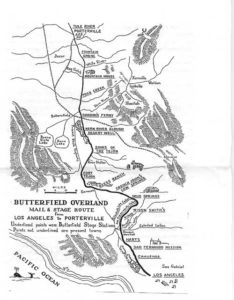It is difficult for me to fully understand what our mountain area was like 150 years ago in spite of the many reminders we have had in recent years. We are in a sparsely settled area now as compared to the local cities, but to imagine only a few hundred people settled in the area and almost totally self-supporting is something I find difficult to wrap my brain around. But, this year we are celebrating an event that was not only important to our area, but to all of the western United States – that is the coming of the Overland Mail stage. The primary stage route in 1858 was right through this area. Because of that importance, this event will be discussed in several newsletter issues.

By 1857 the U.S. Post Office wanted to deliver mail faster to the west especially the Pacific coast than was then being done using ships. Remember that California became a state in 1850 so good communication systems were important not only for personal mail. but newspapers and government communications. (Imagine receiving the news of a presidential election 6 weeks after the event). While stage lines had been running from San Francisco to Los Angeles for quite a while in 1857, the only way to go from east to west was by wagon, horse, or ship (or walking as did many of the 49ers). The Post Office put the idea out to bid and John Butterfield won the bid over nine others. (Mr. Butterfield operated several stage lines in the east)His Successful bid was for weekly service from St. Louis to San Francisco via a southern route to Los Angeles. To achieve this, 139 stations had to be contracted or built at 18-20 miles apart, water sources arranged. 1,800 horses and mules purchased, 250 coaches ordered and about 2,000 people hired and trained. A massive undertaking! The Overland Mail Company spent about one million dollars to set up the stage routes. The contract was issued in September 1857 and the first stage left St. Louis in September 1858 – twelve months later! The route dictated by USPO went from St. Louis south to Ft. Smith, Arkansas, southwest into Texas to Abilene and then west to El Paso. The route then headed north to Las Cruses, New Mexico, and then west again to Tucson, Yuma, San Diego and north by an inland route to Los Angeles. From there, the stages went north through San Fernando. Newhall and Francisquito Canyon (following El Camino Viejo)to Tejon Pass and through the San Joaquin Valley to San Francisco. The trip from Los Angeles to Fort Tejon took 18 hours (later 12 hours) and cost a passenger $12.
Thanks to Bonnie Kane and John W. Robinson for their research and their excellent books that include the information about this event. If you want more information consult A View From the Ridge Route: The Fort Tejon Era (by Bonnie Kane) or Gateways to Southern California by John W. Robinson. Both books are available here.
